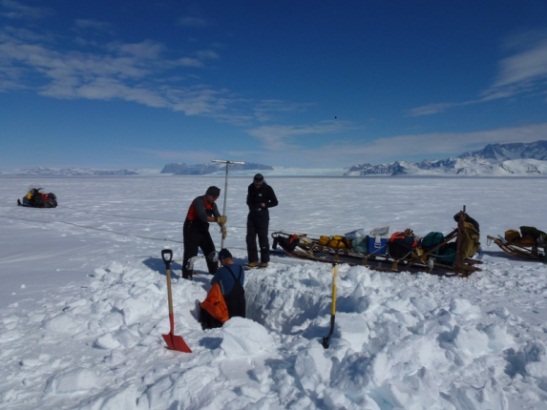Aeolian Research Helps Understand Climate Change

Cliff Atkins is currently leading a research project involving several staff and students from the School of Geography, Environment and Earth Sciences and the Antarctic Research Centre.
The project is focussed on understanding the importance of windblown (aeolian) dust in Antarctica. Variations in the flux of aeolian dust, sea ice extent and productivity occur through and indeed influence cycles of climatic change, so understanding these processes is important for interpreting the record of past climate preserved in drillcores and also for predicting future changes.
Dust is blown from the exposed volcanic islands and valleys in Antarctica onto the surface of sea ice and ice shelves and released into the ocean each summer. It contributes directly to sea floor sedimentation but also provides one source of the micronutrient iron to the surface waters triggering vast blooms of marine algae each summer.
The blooms are major primary productivity events that draw-down atmospheric CO2 and produce large amounts of biogenic sediment (mostly diatoms) that accumulates on the sea floor and ultimately into the stratigraphic record (e.g. ANDRILL cores).
The project is part of a larger Foundation for Research, Science and Technology funded “Past Antarctic Climate/ANDRILL NZ” program (led by Richard Levy, GNS Science) with several Antarctic field seasons having been completed. Two SGEES students are currently involved in the project. Jane Chewing is embarking on a Masters thesis based on samples supported by a Dominion Post Postgraduate scholarship and Iain Richardson is currently working as a summer research scholarship student.
The fieldwork involves travelling long distances over the sea ice and ice shelves on snowmobiles and sledges, collecting snow samples and ice cores. Some sampling involves wearing “clean suits and gloves” and using acid washed equipment and sample bottles. This is a different kind of fieldwork for Cliff who is used to working with rock outcrops and drillcores. “Despite the fact that you often can’t see the dust in the snow, we know the tiny particles of rock are there. We also know that they are an important geological factor in the biogeochemical cycles operating in Antarctica. It just goes to show how varied geological research can be”.
Cliff and Jane Chewings were interviewed by Alison Balance from Radio New Zealand while in Antarctica. To listen to the podcast read here.
